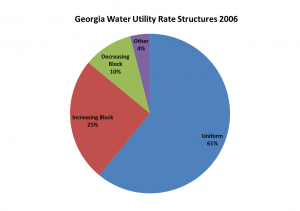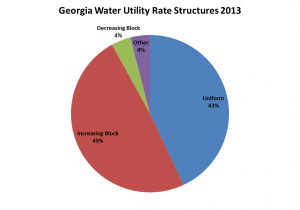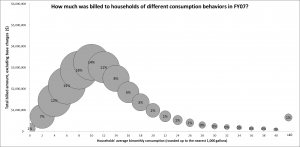 Growing up in a country where school uniforms were mandatory, I viewed uniforms as, well …, “boring!” At least that was the way I felt in high school. One of the most engaging classes I can recall was when the English teacher suggested school uniforms as the topic for our oral debate class. No one wanted to be on the team that had to argue in favor of uniforms. But, even though uniforms are a little plain, I can now admit to seeing many benefits to the students who wear them. Similarly, I feel that uniform water rate structures in the United States may have suffered some shunning, partly due to their “plain” nature.
Growing up in a country where school uniforms were mandatory, I viewed uniforms as, well …, “boring!” At least that was the way I felt in high school. One of the most engaging classes I can recall was when the English teacher suggested school uniforms as the topic for our oral debate class. No one wanted to be on the team that had to argue in favor of uniforms. But, even though uniforms are a little plain, I can now admit to seeing many benefits to the students who wear them. Similarly, I feel that uniform water rate structures in the United States may have suffered some shunning, partly due to their “plain” nature.
As focus has shifted more towards conserving and using water more efficiently, uniform rates have been giving way to increasing block rates (IBRs) in the last couple of decades in the US. With a uniform rate, each unit of water (except for any water included in the base charge) costs the same amount. With IBRs, on the other hand, the water utility sets blocks or tiers at which the price of water increases. For example, if a block is set at 5,000 gallons, a customer who uses 3,000 gallons may pay $4 per thousand gallons for a total volumetric charge of $12. But, another customer using 7,000 gallons would be charged at something higher such as $5 per thousand gallons. IBRs have largely been considered the choice rate structure for conservation purposes. The charts in Figures 1 and 2 show the shift from uniform to IBRs in Georgia utilities over the last eight (8) years (the EFC has been working with the state to study rates over this period). While the occurrence of uniform rates has fallen by 18% over the eight-year period, IBR popularity has increased by 24%.
Revenue Stability and Predictability:
The graph below shows the amount of total dollars billed to one water utility’s residential customers based on average household monthly consumption. The height of the bubble aligns with the total billed amount. The bubble size and the number within the bubble are based on the percentage of households within each consumption category (see the legend to the below for an example of how the graph can be read). The graph is designed to illustrate revenue stability. For example, when a lot of revenue is collected from a small percentage of customers, a change in the behavior of a few could have a significant impact on revenues. If we assume that the average household in this particular part of the country uses about 5,000 gallons per month, then we can consider that use of 15,000 gallons per month to be relatively high, indicating some discretionary use. In this example of a utility with an IBR, about 14% of all households averaged over 15,000 gallons of use in the given fiscal year. This group of customers was charged almost $7 million for water, sewer and irrigation combined.
This depicts a risky situation, where a relatively high proportion of the utility’s revenue is coming from a comparatively small sector of their customer base. This is a vulnerable position, since a change in behavior in this small number of customers would result in a disproportionately large loss of utility revenue. For many utilities, this was a sleeping giant until the economic downturn hit. Other utilities have been pounded with the effects when drought restrictions set in.
Besides the revenue vulnerability posed by the few high-using customers, IBRs make it harder for water systems to make revenue projections. The math is a little more complicated than with a uniform rate structure, posing challenges, especially for systems with more limited staff.
Unfair to Large Households (Or Those who Have a Vegetable Garden)?
The assumption behind an increasing block rate is that when a customer reaches the higher tiers of consumption they are putting water to discretionary use, rather than basic use, hence they should pay more for that water. But this does not hold true for large households. With the economic downturn, household size showed growth for the first time in over a century. Young adults can’t find adequate employment and are moving back to their parents’ homes, while laid off in-laws are moving in to consolidated households. Critics of IBRs raise a good point when they say that this type of rate structure puts an unfairly high price for some water on these already strained household budgets.
We can take this even beyond the mere number of people in a house, to the “value” placed on different uses of water. While most folks may agree that filling a pool is a luxury and should cost more than the water a household uses for cooking, what about something like washing baby diapers? Imagine a young couple welcoming their first baby, incurring the strain to the budget that comes with strollers, childcare and diapers. Yet, they choose to wash cloth diapers for the perceived health benefits to the baby and the earth, but their water bill adds another financial blow if they reach a higher tier. What about the family that decides to grow some of their own food? Is that as “discretionary” a use for water as filling a pool, therefore subject to the same penalty of a higher price for those gallons of water used for watering the vegetables? The point is that, whether you are into diapers, homegrown tomatoes or in-home dialysis, the IBR can raise questions on how our values as a society stack up against each other. This dilemma goes away when each unit of water costs the same.
A Well-Designed Uniform Rate
Perhaps if the uniform rate was designed carefully, it would be sufficiently effective at even water conservation (after all, I know I selected the high school I wanted to attend based mainly on the well-designed snazzy tie!). IBRs with low overall rates and minuscule differentials between consecutive blocks can be trumped by a uniform rate where the cost per gallon is set high enough.
Conclusion
While IBRs may have some amount of psychological impact on customers causing them to use less water or use it more efficiently, the amount of that impact is hard to measure. It seems plausible that the impact is commensurate with a uniform charge, since the basic message is “use more, pay more.” Many water utility education staff argue that it is unrealistic to expect most customers to appreciate more than this simple message.
Maybe we have not outgrown uniform rates yet.









Leave a Reply